Brancaster Chronicle No.60: Anthony Smart Sculptures
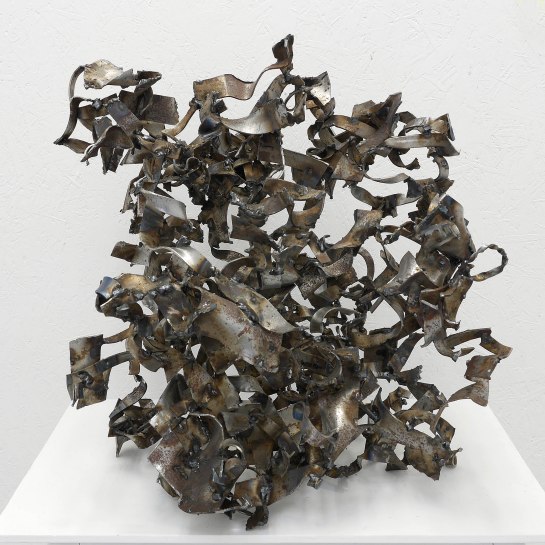
The 2nd Sidney Series No.11, 2017-2018, H70cm. (all sculptures in mild steel)
14th July 2018, the artist’s studio near King’s Lynn.
Taking part: Anthony Smart, Anne Smart, Hilde Skilton, Mark Skilton, Robin Greenwood, Sarah Greenwood, Alexandra Harley, Noela James, Steven Walker, Edward Pile, John Pollard, Richard Ward.
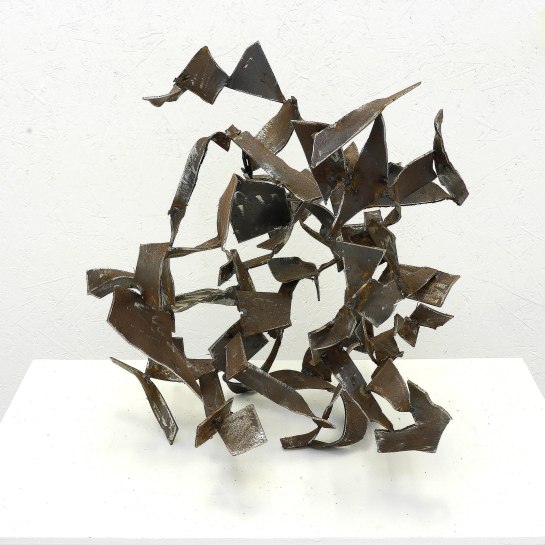
The 2nd Sidney Series No.1, 2017-2018, H55cm.
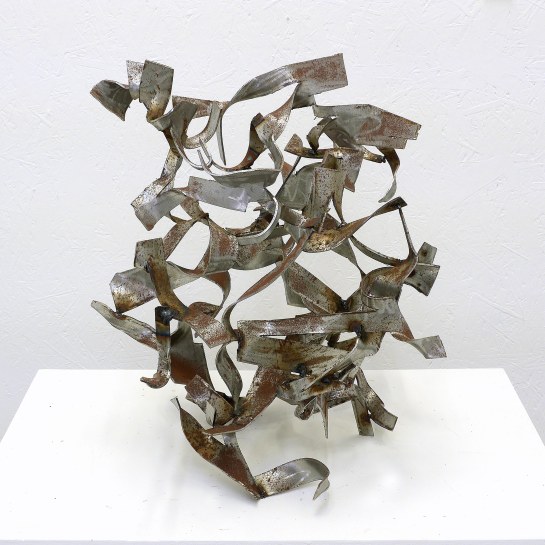
The 2nd Sidney Series No.2, 2017-2018, H54cm.
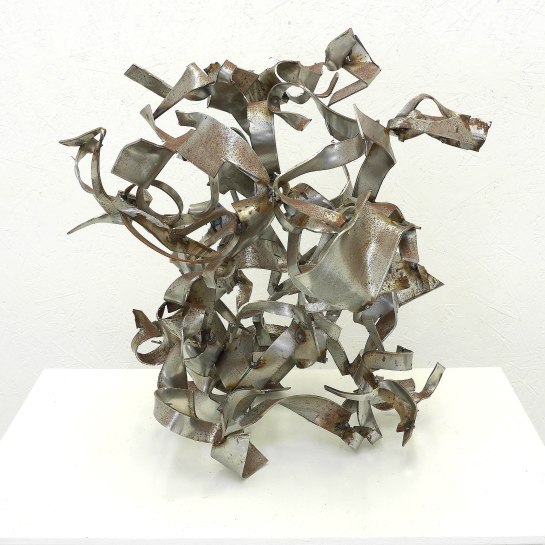
The 2nd Sidney Series No.3, 2017-2018, H61cm.
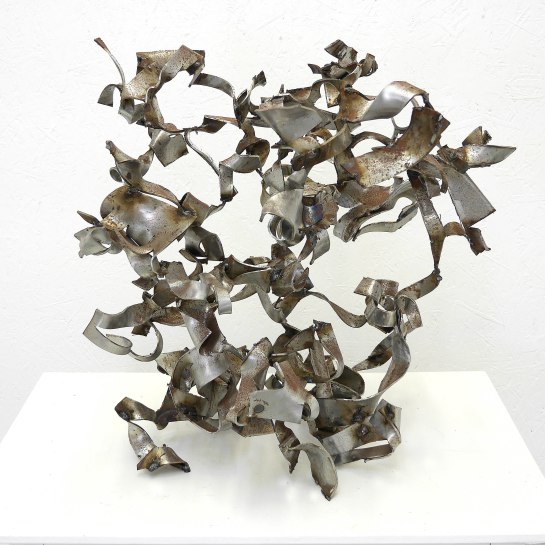
The 2nd Sidney Series No.4, 2017-2018, H59cm.
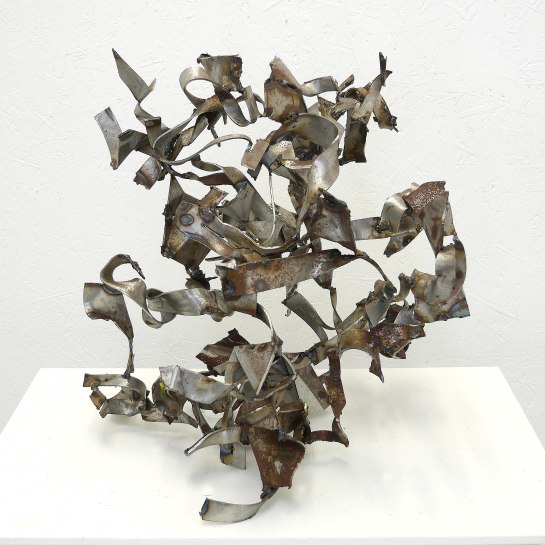
The 2nd Sidney Series No.5, 2017-2018, H56cm.
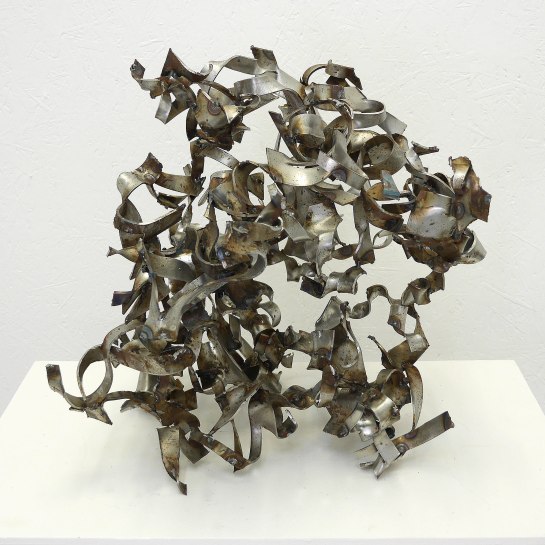
The 2nd Sidney Series No.6, 2017-2018, H57cm.
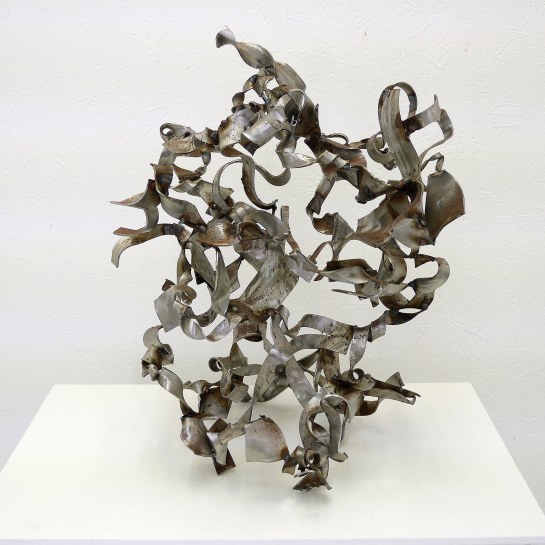
The 2nd Sidney Series No.7, 2017-2018, 67Hcm.
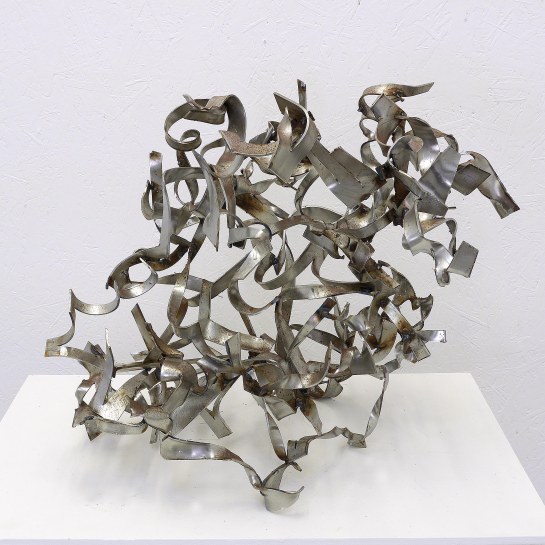
The 2nd Sidney Series No.8, 2017-2018, H54cm.
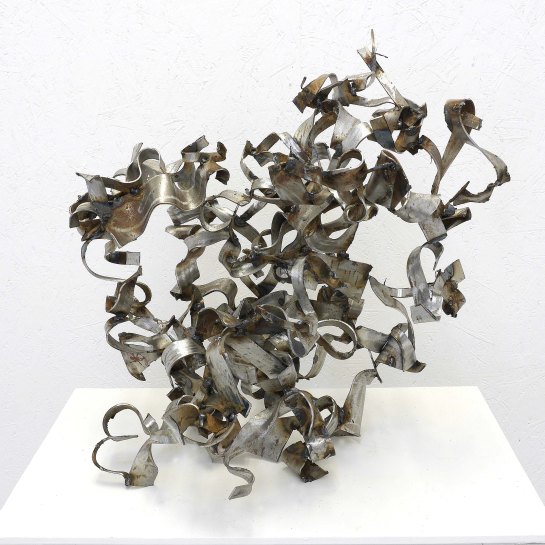
The 2nd Sidney Series No.9, 2017-2018, H70cm.
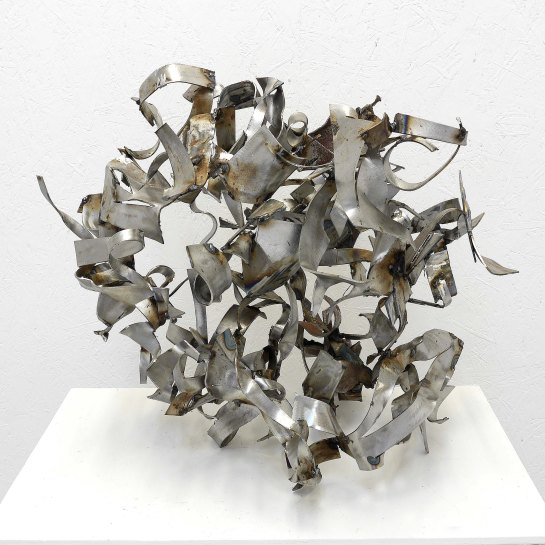
The 2nd Sidney Series No.10, 2017-2018, H62cm.
Robin,
On the topic of ‘wholeness’ you mentioned on Alex’s forum:
It could be a neutral term, or at least a necessary but not sufficient part of a successful sculpture or painting. We have often criticized a work for being made up of parts, some of which may be really interesting, others which are not, and therefore not successfully ‘whole’.
Perhaps there can be a work whose ‘parts’ are all good yet don’t relate successfully enough together and hence lacks wholeness.
However, perhaps you can have a work which has ‘wholeness’ but lacks value, meaning, longevity; its parts working together, colours, shapes, type of mark making, but it may be repetitive or just not have enough content to be of any lasting value. Complex work can fall into this type of unsuccessful wholeness when there is repetition and pattern, or perhaps a simple movement (however energetic it may be).
LikeLike
Regarding these sculptures, here’s wholeness. Not a definition, of course not, because I agree that you can never have a definition of something that is always being redefined by each new specific instance; but here are concrete examples of it, most certainly. Here too is proof, if proof were needed (some do need it), that the Brancaster project of collectively reappraising and mutually redefining abstract art results in not just very good art, but genuinely great art – to achieve which requires a strong instinct for wholeness. Tony has it.
It’s notable that over the past three years of Tony’s sculpture here on Brancaster the degree of activity built into the material from the outset of the work has increased greatly, and the more that he has put in early on, the better the sculptures have become, speaking generally about each series. They also seem individually to be improved by working on them longer once they are up and running. The more complex articulation there is to work with, and the further that work is progressed, the better is the outcome. Compared with previous years, things no longer waft about freely in space round the fringes, nor do they rely so much on the shaped outlines of the flattish pieces. The more recent sculptures manage on the whole quite well to function spatially without much in the way of material physicality, though the bending and shaping of the metal is often present in one’s mind, with both good and less good aspects to that. For me, the less one is made aware of the material’s flat beginnings as thin steel plate, the better. Its manipulation from flat is not the point. and the more things are worked through into a state of abstract content, the more compelling is the spatial vision.
Worth noting that in the photos here the more open sculptures with less material come across best. That’s not my memory of the work, its just a quirk of photography.
The point of complexity (and diversity, if you want to chuck that in too, though Tony is a little light on that) is to synthesise it into something that works together as a whole, not leave it dangling about as complication. All the parts/areas/passages/whatever have to be linked in a convincing and total expressivity (which is a bit more than not being able to take anything out). I’ve always thought that the greater the degree of complexity (and diversity, if you will) that gets accommodated into that coherent mix, the greater the art will be. Wholeness by other means, such as minimalism, is easily achieved and not worth much. But to arrive at the grace of simplicity – or to be more exact, the illusion of simplicity – by way of forging together into a whole the vagaries of complexly articulated material is noble. The complexity gives the resulting appearance of simplicity scope and breadth and manifold meanings. This is all happening in these works.
But in the end, what could be more abstract than getting every part of the content of a work to operate in concert, visually? Cezanne was not the first to do this by any means, but he was, in my book, the first to make it the sentient and unconcealed purpose of the work, over and above all figuration and subject matter, and convey it as an explicit and fundamental principle to be striven for. For me personally there is a direct link to the delivery of wholeness in abstract art, fundamental to its progress.
That’s not to say all here is all beyond criticism, not at all. For example, the raison d’ȇtre of abstract sculpture is NOT to address the condition of being under the influence of gravity, and the very best of these works, “No. 11”, is the subject of a little bit too much focus on that particular “topic” (I don’t even any more consider it a proper part of abstract sculpture’s content), manifested in one or two too many curlicues fussing around its bottom, unnecessarily putting emphasis on how it stands on the plinth. I don’t normally want to pick up on specifics like this, thinking on the whole that the artist knows better than me what to do and what not to do – unless, that is, the specifics impact upon a general “issue”, as they do here, and on which I can offer an opinion.
And, for myself, I think there could also be more diversity of material brought into the work at an early stage, to take the edge off the literal manipulations of the sheet metal. That said, probably all of these new works, plus a couple of the later works from last year, constitute a truly great achievement that moves abstract sculpture purposefully forwards. One can ask for little more. Look and learn.
…………………………………………………..
To return to the Alex/Tim question, which I’ll continue here because it is related, and I think it is better to have only one conversation stream going at any one time:
If one thinks of Tim’s work from the seventies and eighties there is a sense of lengths of material (steel) that are mainly about establishing a direction in space, which either stand, point down like a leg, to the ground, or skim the ground horizontally, or fly off across the top of the work. The finished sculptures often stand like discrete little objects in the world, physically pushing against the ground, often with elements that go all the way from bottom to top. I see this happening in Alex’s work. Works to look at here (by Tim) would be the “Song for Rhythm” series, “Feminine for Structure” series, “From Degas” series, “From Matisse” series. I find the similarity striking, though quite hard to define, and there is more to it than I can presently put into words. Tim’s work is often interesting but lacks both a full-on spatial engagement and a wholeness, which I describe in Tony’s film as happening with HIS new works, and perhaps these two things cannot in abstract sculpture be separated. As Richard says about “Billig Blue”, the space is not made intrinsic and not articulated. I think that is accurate.
Alex works with twigs that are either joined with the ceramic blocks or bound together with string. I’m not convinced that those methods are from a sculptural point of view intrinsically different from applying a weld to steel. So something else has to be going on, other than idiosyncratic methods and materials. Sculpture is about sculpture, not material. If one can imagine taking the twigs out of Alex’s work (a bit far-fetched, but that makes my point), I think you are left with something similar to Tim’s steel elements and how they join – a kind of collaging of interesting pieces of material that does not truly engage with spatiality on a level beyond that which Richard has described. This, to me, is a less abstract and less whole way of sculptural thinking, but it may well have validity in its own right, and the consensus here seems to be that it does.
LikeLike
Activating space seems to me to be a perfectly natural and valid goal for sculpture. Isn´t it the more static (and potentially literal) articulation of space that still has to prove its worth as a goal in itself?
I´m out of my depth here and don´t know how far the analogy can be pushed but isn´t the three dimensional articulation of space in sculpture like the two dimensional (flat) surface patterning in painting, while the activation of space is the illusory element, like the space illusion in a painting?
LikeLike
Yes, maybe, we are back to definitions again; but I think an object – like furniture or a vertical pole – can activate a space, as indeed early Caros did, but they cannot sculpturally articulate it. I don’t think there is anything static about the very three-dimensional articulation of space in these sculptures of Tony’s.
LikeLike
Richard,
The more I think about it, the more I think your original comment on Alex’s feed about “Billig Blue” is very astute – though of course we don’t agree about the values of those different uses of space. And your analogy with John Bunker’s collages puts me in mind of my comment on the inconsistencies of how the wall was and wasn’t used in those collages back in December, and how the space of the wall is sometimes fully integrated into the pictorial articulation, but sometimes remains just a literal background to something a bit less abstract.
LikeLike
Well, you probably understand my comments better than I do!
If you were going to push the painting analogy even further, then the “Cézanne moment” for sculpture might be the combination of both approaches – a fully resolved surface pattern giving rise to a coherent spatial illusion for painting corresponding to a fully resolved spatial articulation giving rise to a coherent “activation” illusion for sculpture.
But don’t ask me to fill in what any of this actually means.
LikeLike
me neither!
LikeLike
Seeing these all together for the first time online I wonder if you are not just going through a process when you make these works. I obviously would need to see them in the flesh to make a proper evaluation but they seem to be very mannered and similar in form. I say this because, correct me if I am wrong here, I thought that as a sculptor you would be concerned with a way of articulating form and producing corporeality. I am suspicious of these works as there are so many of them and on a superficial level they all look the same.
LikeLike
A further thought; the works remind me of Mattises Dance and The Snail. In this sense rather than occupying space they seem to outline, identify and create a space. I think this makes them more about drawing than sculpture.
LikeLike
Hello Nick
I am sorry to have disappointed you on our first encounter.
We seem to agree on the Alex sculpture that you liked.
in your second comment your remark….”identify and create a space”…. gives hope.
Thanks for commenting.
LikeLike
I was not disappointed in the least. I think the work is very interesting. However there are a lot of them and I am not sure if there is much evidence of progression. This may be because I am viewing them in 2d online rather than in the flesh. You mentioned in the film about Alex’s work that you were unsure about the top of Billing Red. I think this shows the ability to take risks when making work. The reason I mention this is because I think that what I am looking at here is a series of pieces thst are almost too sure of themselves. They show that they have a command of space and I particularly like the more open structure of the Second Sydney Series Number One, however I think there is room here to take some real risks in order to move the work to the next level.
LikeLike
Nick
It’s not a stylistic decision or a sudden decision to bring the elements of my sculpture closer together.Currently I think of space and spacing where everything feels the presence of everything else as opposed to a spacing where each has its own space.
For me this is the to-ing and fro-ing of understanding of how to integrate space and material in order to create more feeling and expression. In sculpture there should be purpose in everything and for me space and material are not separate, but if combined in some way they will produce more.
In the ’70’s and onwards I periodically made very dense work. These pendulum like fluctuations are part of exploring the physical conditions and possibilities for expression.
In the case of ‘ Billig Red’ the top piece is not, in my opinion a risk. It is outside the reach of the rest of the sculpture ,in an isolated position and not able to contribute the the rest of the sculpture., but may for some improve the overall shape of the piece.I t needs more empathy from Alex as to why it is there, more work in fact to make it an essential.
You will take note I hope that this was, in the film, on the day, my one and only criticism of Alex’s work this year.
I have demonstrated over the years a grip and understanding of Alex’s work and have done so because of its quality and interest to me as a fellow sculptor.
LikeLike
I’m not sure of the relevance, or the possible implications, of that last sentence. Suffice it to say that if you go back a couple of years you will find me championing the cause of a strange blue-painted wood, wire and ceramic sculpture by Alex – against some critical comment from others. I mention this not for personal reasons, but because it impacts directly upon the (non) discussion of her work and Tony’s. That particular sculpture had a reversal of the roles of the wood and ceramic to what we see in the “Billig” works, whereby the ceramic clusters of quite complex three-dimensional activity were spaced apart by straight sticks. I think you would be able to make a strong case for saying that all three current sculptures are better in some ways than that earlier work, but I would argue that the latter had potential for a greater development of the “articulated” space that Richard has very interestingly brought to the discussion. I have long thought it a shame Alex didn’t follow up on that work. It seems to me a better bet than joining sticks together with simple blocks of ceramic, or indeed, binding sticks together with string.
To explain that a bit more, I need to return to talking about Tony’s “No. 11” sculpture again, and to develop an idea begun in discussion with Sarah this morning. In this latest work, the material is invested with three-dimensionality at a very early stage, by means of twisting and turning and the drawing out of three-dimensional spatiality in each piece, on a micro-scale. This is before the sculpture proper starts, and it’s all speculative regarding how it will get used or integrated, but nevertheless there is already a kind of “proto” sculptural structure in emergent form, at work even before two bits of steel are put together. In other words, the three-dimensionality starts early, and so there is no need for the sculpture to at a later stage attempt to “adopt” or fabricate or construct a structure in space that has the appearance of a sculpture, because its already there, invested in microcosm, from the start, all the way through the whole work. The literalness of construction of so much previous abstract sculpture – of assembling a spatial edifice of any kind – is sidestepped in favour of structure generated from the inside out. A much truer abstract structure this proves to be, in my opinion. To be clear, I take nothing away from all the subsequent work that has to be done with the individual pieces of pre-worked steel to put them together and make them work as a whole, but all the focus can thus go precisely towards that aim.
I think this is a step-change in how we think about structure in abstract sculpture, and it is an extended version of what I have been arguing about for a while now in terms of inventing a new kind of sculptural structure. I’m hoping that makes clear at least a little of my problem with Alex’s new work, which I have said already I feel is somewhat conventional in how it is constructed. I wonder now also if this lack of early investment of three-dimensionality and spatial “opening-out” in the material is in part responsible for Mark’s problems with the lack of articulation of the aluminium blocks that he uses, causing in places the “linearity” in the way they are put together as he strives to impose a structure from the outside?
LikeLike
Yes I feel that Tony has created work which completely flows from beginning to end, in and out, and around. The joins seem so inconsequential one hardly notices them, the sculptures demonstrate a kind of virtuosity. I get what you say about the three-dimensionality starting from the beginning, Robin, the flow is such that there doesn’t seem to much in the way of false turns or awkward moments.
LikeLiked by 1 person
The use of the material energises that ‘flow’ you (Noela) highlight, though I am not sure that flow is the word I would use. It feels too loose a word and these are anything but baggy! the considered articulation of the metal captures the space, (though they are not in themselves aggressive sculptures) and that space is under constant pressure to perform . I do not see the drawing Nick refers to, this may be down to photo v the real thing. What has held my thoughts since I saw them is the incredible way the material has been cut and formed so it has a relationship to near neighbours and across the sculpture. Small shifts in a sight line creates a new augmented vision. Maybe this is the wholeness Robin speaks of
LikeLike
Many thanks Robin for your very generous appraisal of my sculptures.
Thank you also to Noela.
So far this debate has concentrated on the ‘how’ and not the ‘what’ .
The question of theory ? ….your theory Robin, is interesting, and the bit I do agree with is the “early investment idea”.
But honestly, and not to be contrary, this idea is at the front line of an evolving practice of familiarising oneself with the stuff you are working with.
I think the use of the scrap pile ,all of those chopped up remnants and off cuts that can be more appetising and spontaneous than any 8 by 4 sheet of steel,is an early instinctive way of perhaps speeding up the process of getting to grips with the possibility of a fast and intuitive construction of steel.[ lets remember that the previous generation had at this point only just started to engage with a free style ,make it up as you go along approach that did not involve the use of readymades]
After reading your comments I watched some of Alex’s Chronicle with the ‘blue sculpture’ to which you referred. Alex said she had made the ceramic parts a while ago and had not been sure what to do with them. She decided to group them eventually on the ends of sticks and paint the whole piece. This is to me an example of just what you are talking about.
Mark, in a long conversation with Anne in an early Chronicle of his, explained the making of parts ,on the bench , away from the sculpture, and then bringing them to the sculpture later on [ Anne saw this as a negative but as time has gone on this has been adopted as a positive ].Of course the advantage of this ,as you rightly point out Robin, is the ‘early investment’ in three dimensionality. Another example of what we are talking about. Maybe Mark ditched the idea ,but I rather think it has been evolved within his ways of working.
Both Mark and Alex and you Robin and myself are involved in a varying form of freestyle sculpture.
Of course the only bit of that which really means anything is what we all come up with!
LikeLike
Your determination to insist that nothing is new means you mis-remember the reason why Anne had a problem with Mark making stuff on a bench away from the sculpture – it was because he was making stuff at the time to fulfil a structural function, which then slotted into a big idea about configuration.
As well as the early investment in three-dimensionality, it is undoubtedly the speculative uncoupling of that three-dimensionality from literal structure and the embracing of ‘free-floating’ intentionality that provides the crucial factor in allowing for more abstract values to emerge. Things have changed.
And, yes, that was the very reason I brought up the blue sculpture by Alex from 2 years ago. But thanks for the reply. Be nice to hear from Alex, or indeed anyone else!
LikeLike
I think these works have moved beyond a noticeable “place and pause” approach and I also do not actually feel like they are flowing at all. The only movement I felt was mine when I was actually looking at them. They seem to grab their space and really own it. The materiality is being transcended by the content of the work. So I don’t get an obvious handle on the decision-making (I do not find myself asking how was that done?) – they just seem to exist pretty comfortably in a take it or leave it state. Where next? The extremes of the works could be an intriguing proposition to explore. I remember noticing a ‘cuteness’ of decision-making at the extremes on one last time – a sort of probing into the air with a piece, when perhaps a more direct or inventive solution could be found, whereas these ones have more emphatic ‘endings’. I wonder if they could get more economical in the steel to get the same complexity too? Or might that defeat the principles? I saw them one evening before the Chronicles started and they were really memorable and such a pleasure to behold.
LikeLike
I like very much the way you have taken on this “movement” thing Emyr.
What I would add is ,the movement, in being ” contradicted ” creates a tension, and I think that is felt both spatially and abstractly, and maybe it is these tensions, in varying combinations, that become the structures of the three dimensionality.
I would hope that because of this, that the shape of the sculpture, as has been pointed to , is not a concern.
As has been said they are sculptures that are ‘looked into ‘ as much as ‘looked at’.
LikeLike
Is the movement ‘contradicted ‘ because the angularity of the elements is in direct contrast with the next stage of construction, ie the bends and twists. The second stage of making, the turns and bends initially appear to override the cuts. I feel this contradiction is exciting and adds momentum
LikeLike
Thanks Alex.
The way I am seeing this is of taking the elements of sculpture and synchronising them somehow, accepting/encouraging contradictions within, to create more interplay of material and space.
This is to get the sculpture to be as far away from being an object as possible, and have a real role for abstract sculpture that owes as little as possible to other art forms and anything else.Hopefully giving it a real life of its own.
Surely there should be room for the viewer to rummage around imaginatively and not be told what to think or feel.
Maybe the way in for the viewer could be via the unresolved loose ends caused by this contradiction?….This is just a fanciful thought but you seem to be in the vicinity and bits of this have been said by all of us for some time.
Mark sees indeterminacy as a positive at the moment, and I agree.
“Momentum” and how it comes into existence could be abstract. Movement is more likely to be figurative.
LikeLike
Alex…as a PS
Your point about the cuts/contradiction/momentum ….,,the more I think about it, the more provocative [ in a good way] that remark is …and I am still thinking about it…..
LikeLike
The movement of the eye following a line of steel as it twists through space is not really what’s in these for me, even though the choice to look at them in this way is evident. That whole endeavour seems connected to earlier works which now look more ‘weighed up’ akin to a placement of steel and the subsequent regarding of it against another piece of steel (literally relational) ; a linear process. I thought these seemed to deny that – more contrived perhaps – reading of form and space and made a more urgent claim on an entirety of space – or perhaps a better way to put it they get beyond that linearity of decision-making (as they have to be made somewhat sequentially I would assume).
The stakes seem to be raised when more steel is added too; counterintuitively speaking, increasing the steel and its subsequent potential is actually opening up space rather than crowding it out. I return to my article on space (part 2): movement is created through differences (inter-relationships) and this movement (of our eyes as we take difference in) creates the space. More steel entails much more decision-making due to the consequences of its attitude and momentum.
These works are not sitting back in a space, they’re grabbing for their space and holding it in a sculptural space. The work has been put in; call it tension, pressure, contractions and expansions etc, whatever really – that’s Tony’s bag not mine as I can appreciate all that but I don’t really care at the end of the day. I just really appreciate all the work has been done for me so I get the freedom. I think ideally they need a lot of space to view them singularly, as in close proximity the fizz of their visually overlapping forms can crowd neighbouring works and make it a challenge to really see one – fully.
We’ve taken the kids to the pantomime (oh yes we did!) at Christmas and I remember a famous celebrity cracking “in- jokes” throughout the performance which really bugged me as all I wanted to see was a full-on show. These are full on…sorted…. It’s behind you!
LikeLike
Space and how we engage materially as well as visually (we seem to have varying perceptions so I have separated them) has come in for a great deal of scrutiny. This issue of space has cropped up with painters too. I have been painting my sculptures, Mark and his aluminium and Robins mixed media have all had to deal with varying colour. Is this relevant? Does, for example, using lighter tones affect our perception of the interiors and / or our ability to engage with condensed, centralised space.
Emyr says that Tony’s sculptures need space around them to be really appreciated fully, I think this goes for all of us.
LikeLike
You have to factor into this mix how spatiality interacts with physicality. The balance keeps shifting, and the great thing about Brancaster is being able to kick these issues around in a way that doesn’t happen anywhere else. It keeps it all live, and it still feels like we are just scratching the surface.
One thing that has been of interest to me is how little space I need to make the work. This may be different from what’s needed to see it (though even there I’m not so sure, as we look into rather than at sculpture quite so much), but the whole thing of making from the inside out seems to have brought a changed perspective from even a few years ago.
LikeLiked by 1 person
Mark said last year that he was condensing space and the result was a hugely different animation of space and material through his sculpture. It was a comment that has really had me scratching my head since. I felt that he was / is trying to create not just a symbiotic relationship with the space and material, but a relationship that is completely co-dependent. Does your first comment Robin, re the ever changing spatial/physical balance mean that you think the space and material are separate? And with Tony’s sculpture, the are constructions with complex elements cut and formed – rather than welded individual blocks -is that balance affected by the changing articulation of the elements.
LikeLike
I’m still working with the idea that space in a sculpture is a very different thing than space not in a sculpture, even though literally you could say its the same, as Mark suggested, because to me it starts to feel so different. I now think of the key to the material/space conundrum is down to the integration of the two into one thing. This obviously relates to wholeness, but also to the idea of space being far more than simply “occupied” by material, but being fully owned and engaged by the content. Once the space starts to be “articulated”, to use Richards idea, then it’s inseparable from the material. The thing that is amazing me across the board this year is the shear amount of content, spatial and physical combined, that is being synthesised into the work, to an extent undreamt of previously. OK, some of this has problems, but some of it is really working, and it’s all going the same way. I’m still not into the ‘indeterminacy’ thing, but there seems a kind of endlessness to how far this abstract stuff can all be taken. Mind-blowing!
LikeLike
Whilst I may be coming at this a little late, I’d like to say that I was blown away by the photo of No.11 when it was posted, and I was very glad to see it receive so much praise in the discussion. I completely agree with Emyr’s take on the sculptures, that the experience of them is not a linear one, or at least doesn’t have to be. It’s not that the eye doesn’t keep wanting to move around the whole thing, but that movement is not dictated by a literal and deterministic articulation. We just keep getting bounced around by all the fabulous stuff.
But that stuff keeps you moving, because individual bits rarely if ever seem to assert their presence over and above all the other moments within the work. Tony’s push to de-objectify sculpture and de-materialise the steel seems to account for this, and is reflected by his completely un-precious attitude to the works, maintaining that they are moments of pause on the way towards something else. This doesn’t devalue them at all, but probably emphasises their significance, because they are the evidence of progress. There is much to be learned from his approach.
LikeLiked by 1 person